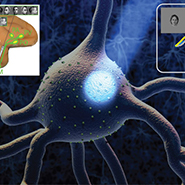The spiking patterns of the neurons at different fMRI-identified face patches show a hierarchical organization of selectivity for faces in the macaque brain: neurons at the most posterior patch (ML/MF) appear to be tuned to specific view points, AL (a more anterior patch) neurons exhibit specificity to mirror-symmetric view points, and the most anterior patch (AM) appear to be largely view-invariant, i.e., neurons there show specificity to individuals (Freiwald & Tsao, 2010). This project proposes and implements a computational characterization of the macaque face patch system. Our main hypothesis is that face processing is composed of a hierarchy of processing stages where the goal is to "inverse render" a given image of a face to its underlying 3d shape and texture. The model fine-tunes and wraps a powerful feed-forward computational pipeline within a generative vision model of face shape and texture. This project aims to explain neuronal and behavioral data, and generate testable predictions about the macaque face processing system.
Neural Circuits for Intelligence
 Abstract thinking and complex problem solving constitute paradigmatic examples of computation emerging from interconnected neuronal circuits. The biological hardware represents the output of millions of years of evolution leading to neuronal circuits that provide fast, efficient, and fault-tolerant solutions to complex problems. Progress toward a quantitative understanding of emergent intelligent computations in cortical circuits faces several empirical challenges (e.g., simultaneous recording and analysis of large ensembles of neurons and their interactions), and theoretical challenges (e.g., mathematical synthesis and modeling of the neuronal ensemble activity). Our team of theoreticians and neurophysiologists is focused on systematic, novel, and integrative approaches to deciphering the neuronal circuits underlying intelligence. Understanding neuronal circuits that implement solutions to complex challenges is an essential part of scientific reductionism, leading to insights useful for developing intelligent machines.
Abstract thinking and complex problem solving constitute paradigmatic examples of computation emerging from interconnected neuronal circuits. The biological hardware represents the output of millions of years of evolution leading to neuronal circuits that provide fast, efficient, and fault-tolerant solutions to complex problems. Progress toward a quantitative understanding of emergent intelligent computations in cortical circuits faces several empirical challenges (e.g., simultaneous recording and analysis of large ensembles of neurons and their interactions), and theoretical challenges (e.g., mathematical synthesis and modeling of the neuronal ensemble activity). Our team of theoreticians and neurophysiologists is focused on systematic, novel, and integrative approaches to deciphering the neuronal circuits underlying intelligence. Understanding neuronal circuits that implement solutions to complex challenges is an essential part of scientific reductionism, leading to insights useful for developing intelligent machines.

